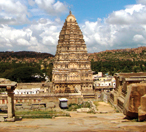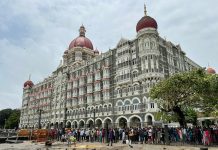 A shining beacon of India’s rich historical legacy as well as set among a fascinating boulder-strewn landscape, it’s hard to understand why Hampi doesn’t enjoy a more prominent position on the traveler circuit. Declared a UNESCO World Heritage site in 1986, it was the capital of Vijayanagar empire from the 14th to 16th century and now attracts visitors for its medieval temples as well as its spectacular topography.
A shining beacon of India’s rich historical legacy as well as set among a fascinating boulder-strewn landscape, it’s hard to understand why Hampi doesn’t enjoy a more prominent position on the traveler circuit. Declared a UNESCO World Heritage site in 1986, it was the capital of Vijayanagar empire from the 14th to 16th century and now attracts visitors for its medieval temples as well as its spectacular topography.
GETTING TO HAMPI
Hospet, at a distance of 13 km is the closest transport hub. Regular buses run from Bangalore and Hyderabad as well as a few trains. The best option to arrive from Mumbai remains an overnight bus ride. The short journey from Hospet to Hampi can be made by rickshaw (approximately Rs. 120) or the much more economical government buses that run every 20-30 minutes. (Rs.10)
WHERE TO STAY AND EAT
Within Hampi, the best bet is to cross over the Tungabhadra into Virupapura Gaddi where a variety of quieter and cheaper options are available than near the main bazaar. A frequent boat service will ferry you across the river from the docks (a few hundred metres from the heart of Hampi Bazaar) for Rs.10 or else one can enlist the services of one of the ubiquitous coracles (circular bowl shaped boats common to the region).
Most guesthouses have decent restaurants offering cuisine ranging from Chinese to Israeli to Italian in order to cater to the international guests. While alcohol is prohibited, most places across the river keep bottles of beer stashed in their refrigerators and can produce it on request, even if not listed in the menu. A must-eat place is the immensely popular Mango Tree Restaurant, offering a fine view of the Tungabhadra river and surrounding rocks.
THINGS TO DO THERE
SOAK IN THE HISTORY
Hampi provides an opportunity to explore the remaining vestiges of a once thriving empire, offering glimpses into the grandeur and fine architectural work of the Vijayanagar kingdom.
Before venturing out for a day of sight-seeing, a necessary purchase is a detailed map of the area showing the different sites to be visited. They are fairly well-spread out so one needs to rent a bicycle or motorcycle to get around.
The main sights include the Virupaksha temple, at the heart of Hampi Bazaar. It is one of the oldest structures in town, rumoured to have been built in the 7th century, and one of the few active temples. Consequently, it tends to be quite crowded with people (devotees and tourists) and monkeys alike and is home to Laxmi, the temple elephant. The upper levels of the main tower are famed for their stucco figures. Spread out overlooking the temple is Hemkuta Hill, a giant rocky slope, dotted with small ruins and offering a bird’s eye view of town.
Walking down the old royal road, now home to shops and souvenir sellers, takes one past a monolithic Nandi statue, and onwards to the Achutyaraya temple- a walled enclosure with the beautifully carved temple standing in the midst of a lush green lawn.
The undisputed jewel among the architectural wonders of Hampi is the Vittala temple, built in the 15th century. It is a massive compound, housing several temples with detailed, mythological carvings, an underground inner sanctum and the famed stone chariot- an iconic image of Hampi. The walk back from the Vittala temple takes one past breathtaking curves of the Tungabhadra River, flanked by high cliffs and green banks, with the occasional coracle returning from a day of fishing.
Other highlights of the area include the sprawling Royal Centre (about 3 km from Virupaksha) – containing the Elephant Stables and Zenana Enclosure, as well as the monolithic statues of Ganesh and Narasimha.
EXPLORE THE BOUNTY OF NATURE
For many, overshadowing the man-made wonders of Hampi are those wrought by Mother Nature. Massive boulders dot the surrounding hills as far as the eye can see, often looking as if they’ve been precariously stacked on top of each other- a giants’ unfinished game of pitthoo.
It’s an explorer’s dream – trekking along faint paths through the shrubbery, clambering up hills strewn with weathered remains of boulders, and getting up high enough to be rewarded by sweeping, awe-inspiring views – hills, trees, fields, ancient temples and finally, the glimmering river – the central, binding theme in nature’s portrait.
There are also some lovely spots for cooling off in the Tungabhadra, past the Bukkas Aqueduct on the way to the Hanuman Temple.
Hampi is a mosaic of rural openness and historical richness- a place where the immensity of nature and the marvels of an era gone by combine together to instill a feeling of peaceful contentment.
Things to keep in mind
- The last boat to ferry people across the river on either side is at 6pm. One must factor this in if planning a day of sightseeing or catching a bus back to Hospet.
- Either a good reference book or a guide is a must and worth the expense while exploring the temples to give a historical backdrop.
- Unless experienced in camping, returning to your guesthouse before dark is a good idea as it is easy to get lost while exploring. Carry torches as there are frequent power cuts.
Volume 1 Issue 7































